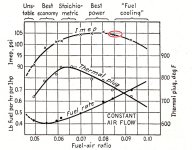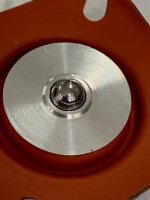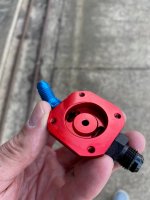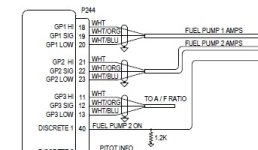Hello Dan!
Marvin, "standard target EGT" means you adjust mixture with the rotary knob to reach a target EGT?
Yes, I use target EGT (manually rotate the knob) for climb on all flights and for takeoff when I get more than 4,000’ from my base airfield. This is a choice when setting up the SDS system. Auto lean can be programmed, I chose not to do so because I use the system for WAY more than cross country and the secondary curve is important for my varied types of flights. I like having a base curve set as a standard ROP situation at all altitudes (personal choice). The secondary curve is really a linear shift (ignition) and/or a percent fuel reduction, as programmed by the owner.
I set my system up as follows (I suspect you could help me find a better compromise):
Base curve is set every 100RPM as a function of AFR and MAP. 2500RPM and above are set for Sea Level full takeoff power, 175 degrees ROP. Once below 2500RPM I am set for 100ROP for the remainder of the flight. There is an aneroid barometer that adjust for air density and I have tested it to 17,500’MSL many years ago, the results of that test were satisfactory, but as you know I am an engineer at heart. I still use the knob to maintain the target EGT. I probably save less than 1/2 a gallon of fuel for the total flight, but it gives me something to do. Once in cruise, I have the option of manual control or curve 2.
The SDS controller will display fuel knob percentage off zero. From Sea Level to 4,000’ DA I leave the knob at zero. From 4,000’ through 12,000’ DA I vary the knob linearly up to -11%. This procedure is no different than the yellow line I painted near the mixture knob on my last aircraft with a standard aviation carb, except I can see a consistent number on the controller. So less guess work. During the initial climb I adjust for target EGT the same way I did with my carbed aircraft; however, the adjustments tend to be less necessary and the EGT far more reliable. Once in cruise, I typically set the fuel at -30% sometimes -33% as a function of altitude, up to 50% is available. I’m actually choosing a value relative to PEAK EGT. I removed the O2 sensor more than 800 hours ago.
The secondary curve can adjust timing and fuel percentage individually or together. Because the ignition is a linear offset from the base curve and the fuel reduction is shown in percentage, I have a system for setting Curve 2 based on my anticipated flight and I can change my mind in flight with no adverse effects. I use Curve 2 several different ways.
- Standard local flights.
- Long LOP flights
- formation flights
- Aerobatics at altitude
- occasionally long LOP climbs
The above is why I chose my base curve, every flight is relative to a known starting point. Were I to use mogas, an O2 sensor, and closed loop my choices would be significantly different.
As far as one fuel pump versus two, my preference is two pumps below 1000AGL. It just makes me happy. My fuel pressures vary similar to what was posted by TooBuilder. If there is an over rich condition with two pumps I have never noticed it, possibly because I have a system for takeoff based on DA?
You and I watched a carbed O-540 make a poor attempt at an over-rich takeoff in Leadville last year. Your aircraft (mechanical) and mine (EFI) did quite well. Perhaps Ross will read this and improve upon my understanding of the SDS system. I’m a gear-head wannabe, with limited experience on only one EI/EFI airplane. I am very open to improvements on my use of the system which is why I love this forum. Perhaps Ross will read this and offer an improvement on my understanding of SDSEFI.










